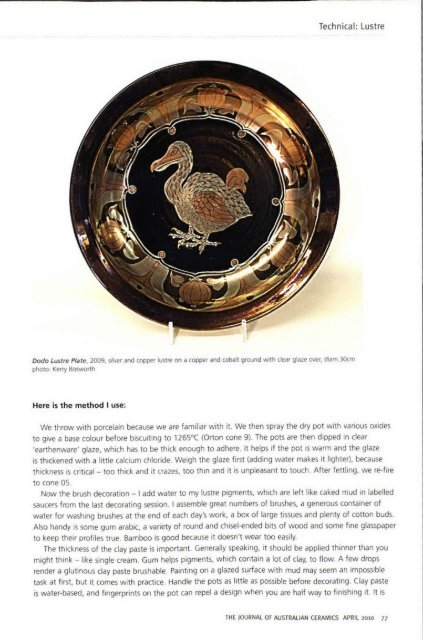The Journal of Australian Ceramics Vol 49 No 1 April 2010
You also want an ePaper? Increase the reach of your titles
YUMPU automatically turns print PDFs into web optimized ePapers that Google loves.
Technical: Lustre<br />
Dodo Lustre Plate, 2009, sIlver and copper lustre on a copper and cobalt ground with clear glaze over, diam.3Ocm<br />
photo; Kerry Bosworth<br />
Here is the method I use:<br />
We throw with porcelain because we are familiar with it. We then spray the dry pot with various oxides<br />
to give a base colour before biscuiting to 126S 0 C (Orton cone 9). <strong>The</strong> pots are then dipped in clear<br />
'earthenware' glaze, which has to be thick enough to adhere. It helps if the pot is warm and the glaze<br />
is thickened with a little calcium chloride. Weigh the glaze first (adding water makes it lighter), because<br />
th ickness is critical - too thick and it crazes, too thin and it is unpleasant to touch. After fettling, we re-fire<br />
to cone as.<br />
<strong>No</strong>w the brush decoration - I add water to my lustre pigments, which are left like caked mud in labelled<br />
saucers from the last decorating session. I assemble great numbers <strong>of</strong> brushes, a generous container <strong>of</strong><br />
water for washing brushes at the end <strong>of</strong> each day's work, a box <strong>of</strong> large tissues and plenty <strong>of</strong> cotton buds.<br />
Also handy is some gum arabic, a variety <strong>of</strong> round and chisel-ended bits <strong>of</strong> wood and some fine glass paper<br />
to keep their pr<strong>of</strong>iles true. Bamboo is good because it doesn't wear too easily.<br />
<strong>The</strong> thickness <strong>of</strong> the clay paste is important. Generally speaking, it should be applied thinner than you<br />
might think - like single cream . Gum helps pigments, which contain a lot <strong>of</strong> clay, to flow. A few drops<br />
render a glutinous clay paste brushable. Painting on a glazed surface with mud may seem an impossible<br />
task at first, but it comes with practice. Handle the pots as little as possible before decorating. Clay paste<br />
is water-based, and fingerprints on the pot can repel a design when you are half way to finishing it. It is<br />
THE JOURNAL OF AUSTRALIAN CERAMICS APRIL <strong>2010</strong> 77


















